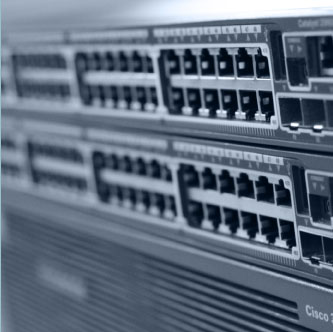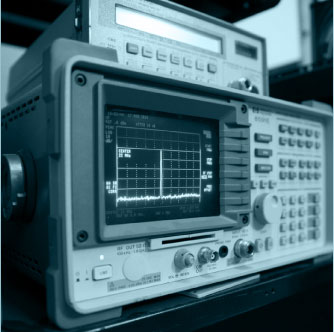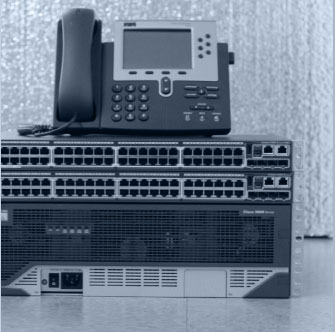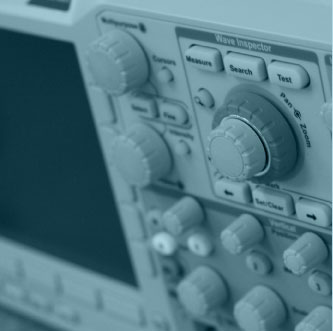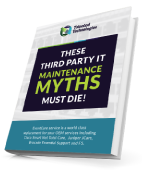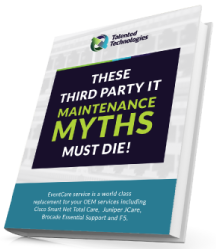 https://www.pexels.com/photo/code-projected-over-woman-3861969/
https://www.pexels.com/photo/code-projected-over-woman-3861969/
We live in a society of instant gratification. We all want that shiny new thing – the latest smartphone with three cameras, the fastest processor, the cool wearable tech that does everything from check how many calories you’re burning to turning your lights off when you’re not home.
This culture of acquiring new stuff brings with it a tendency to toss a lot of stuff out that is still quite functional. The implications in terms of financial waste and e-waste can be pretty extreme. Oftentimes, we don’t need to toss out equipment that can still be used. Especially when you consider these statistics from the Electronics Take Back Coalition: It takes 539 pounds of fossil fuel, 48 pounds of chemicals, and 1.5 tons of water to manufacture one computer and monitor.
If you are running a business and you are thinking of getting rid of perfectly good equipment you should consider that there are several ways to extend the life of your IT equipment, and the best way is by deleting data.
Just what falls under the umbrella of IT equipment?
According to Webopedia, even though IT is often used to describe computers and computer networks, it actually includes all layers of the systems within an organization — from the physical hardware to the operating systems, applications, databases, storage, servers, and more. Telecommunication technologies, including the internet and business phones, are also part of an organization’s IT infrastructure.
Typically, when a subsystem or storage system has reached the end of its service life, maintaining it costs more than it’s worth to keep it running.
One of the top reasons companies do not bother with data deletion is that it can be time-consuming to research all the existing files to determine which ones are OK to delete. Some files may have been created by a former employee and the company does not want to assume the risk to their business if important data inadvertently gets erased.
Things to understand about data erasure before you get started:
Deleting is not deleting
An important distinction must be made between deleting data, HDD wiping, and erasure. It’s important to understand these things because if sensitive data ends up in the wrong hands you could have a situation on your hands with serious competitive or even legal consequences. You want to avoid a data breach like this at all costs.
You can wipe a hard drive by getting special software, but this does not remove the data, it simply makes it unreadable.
Data destruction or data erasure makes data totally unreadable regardless of the form of electronic media on which it was originally stored. This is the step to take if your equipment is completely outdated and you’re ready to replace it.
So, if you’re concerned about your bottom line, these are the two top reasons why data deletion can help extend the life of your IT investment.
- Make Better Use of Your Office Space
 https://www.pexels.com/photo/business-businessmen-classroom-communication-267507/You may be paying rent for space you don’t even need. With today’s cloud storage technology and software options, you may be able to declutter to the extent that you find your physical office space can be used much more efficiently, which can represent substantial monthly savings.
https://www.pexels.com/photo/business-businessmen-classroom-communication-267507/You may be paying rent for space you don’t even need. With today’s cloud storage technology and software options, you may be able to declutter to the extent that you find your physical office space can be used much more efficiently, which can represent substantial monthly savings. - Use existing equipment
 https://www.pexels.com/photo/silver-imac-displaying-collage-photos-1779487/The most compelling reason to remove unused data is to increase the life of your equipment, instead of replacing it. Cold data – inactive data that is rarely used or accessed – can be moved to free up space on your hard drive. You can move this data to tape or possibly AWS glacier storage (the cloud) if you no longer think you need it. Once on tape or in the cloud, you can recall or restore it if needed.We spoke to an IT specialist at Hitachi who recommends the most economic way to approach this is from a software perspective. Usually, the data is stored and tracked by a specific software product like Oracle or Splunk or Teradata. Newer versions of the software often include utilities to find data that has not been referenced, and then allow the user to move that data to a more effective tier (like the cloud (S3), etc.).Therefore, it’s prudent to research the software product that stores the data to see if they have a newer version that allows you to move that data and offload it to the cloud. Typically, newer releases of the software can handle this and it’s a win-win, as your data removal is handled, and the software company gets to renew your contract.
https://www.pexels.com/photo/silver-imac-displaying-collage-photos-1779487/The most compelling reason to remove unused data is to increase the life of your equipment, instead of replacing it. Cold data – inactive data that is rarely used or accessed – can be moved to free up space on your hard drive. You can move this data to tape or possibly AWS glacier storage (the cloud) if you no longer think you need it. Once on tape or in the cloud, you can recall or restore it if needed.We spoke to an IT specialist at Hitachi who recommends the most economic way to approach this is from a software perspective. Usually, the data is stored and tracked by a specific software product like Oracle or Splunk or Teradata. Newer versions of the software often include utilities to find data that has not been referenced, and then allow the user to move that data to a more effective tier (like the cloud (S3), etc.).Therefore, it’s prudent to research the software product that stores the data to see if they have a newer version that allows you to move that data and offload it to the cloud. Typically, newer releases of the software can handle this and it’s a win-win, as your data removal is handled, and the software company gets to renew your contract.
In a nutshell, deleting data that is no longer needed or in use is an excellent, cost-effective way to get rid of outdated or unnecessary data without having to purchase any new equipment. The money you save can then be applied to other parts of your organization like increased marketing efforts, updated software, and employee salaries.

